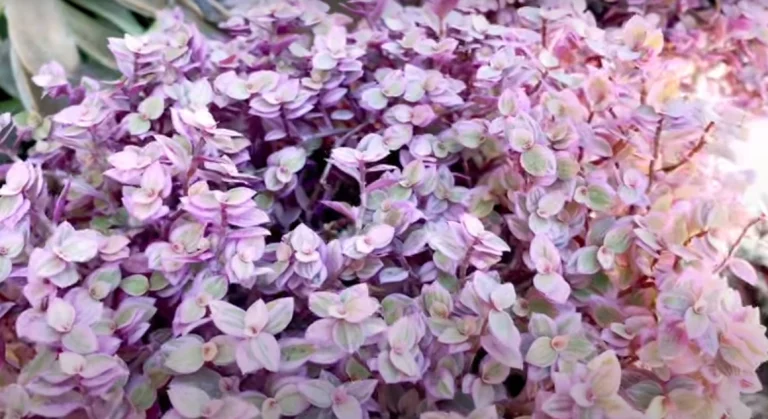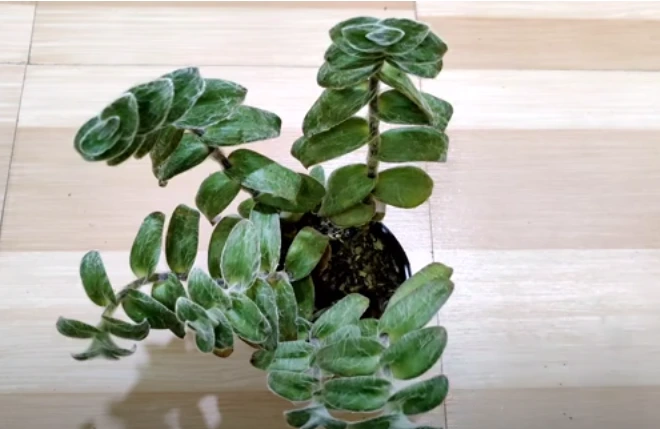Tradescantia Resource Guide
Tradescantia is a genus of over 70 flowering plant species in the family Commelinaceae. Commonly known as spiderwort or inch plants, Tradescantia are popular ornamental plants native to the New World tropics. They are characterized by their long arching leaves and small 3-petaled flowers. Tradescantia are easy to care for, propagate, and come in a variety of colors and leaf forms. They make excellent houseplants or outdoor groundcovers.
Tradescantia Varieties and Types
Tradescantia Zebrina
This spiderwort is beloved for its striking purple and silver striped foliage. The leaves have a soft velvety texture.
- Leaf Color: Dark green with silver stripes, purple undersides.
- Leaf Size: Long, slender leaves up to 5 inches.
- Growth Habit: Trailing or cascading.
- Availability: Common and easy to find.
Tradescantia Pallida
Known for its fuzzy gray-green foliage that adds unique texture.
- Leaf Color: Velvety gray-green leaves.
- Leaf Size: Narrow leaves up to 6 inches long.
- Growth Habit: Trailing or cascading.
- Availability: Readily available.
Tradescantia Nanouk
Grown for its pink-striped leaves that offer a pop of color.
- Leaf Color: Green with pink stripes.
- Leaf Size: Oval leaves up to 4 inches long.
- Growth Habit: Trailing.
- Availability: Popular and widely available.
Tradescantia Fluminensis
A fast-growing groundcover known for its vibrant green leaves.
- Leaf Color: Green.
- Leaf Size: Narrow, pointed leaves up to 4 inches.
- Growth Habit: Spreading groundcover.
- Availability: Readily found and cultivated.
Tradescantia Spathacea
Unique boat-shaped succulent leaves give this plant its distinctive look.
- Leaf Color: Green.
- Leaf Size: Fleshy oval leaves up to 5 inches long.
- Growth Habit: Clumping.
- Availability: Fairly common.
Tradescantia Pink Panther
Pink variegated leaves make this one stand out.
- Leaf Color: Green with pink stripes.
- Leaf Size: Narrow pointed leaves around 5 inches long.
- Growth Habit: Trailing.
- Availability: Less common but gaining popularity.
Tradescantia Bubblegum
Young pink and green striped leaves turn solid green as they mature.
- Leaf Color: Pink and green stripes when young, maturing to green.
- Leaf Size: Slender leaves around 4 inches long.
- Growth Habit: Trailing.
- Availability: Unique variety that is harder to find.
Tradescantia Sillamontana
Grown for its fuzzy white leaves that give it a velvety soft appearance.
- Leaf Color: Green with white hairs.
- Leaf Size: Oval leaves up to 3 inches long.
- Growth Habit: Trailing.
- Availability: Uncommon, a unique variety.
Tradescantia Albiflora
Known for its prolific white flowers that cover the plant in bloom.
- Leaf Color: Green.
- Leaf Size: Slender pointed leaves around 5 inches long.
- Growth Habit: Upright clumps.
- Availability: Less common.
Tradescantia Blushing Bride
Produces showy bicolored flowers in white and soft pink.
- Leaf Color: Green.
- Leaf Size: Slender leaves up to 5 inches long.
- Growth Habit: Clumping.
- Availability: Uncommon but available.
Tradescantia Purple Heart
Grown for its deep royal purple foliage that retains color in lower light.
- Leaf Color: Rich purple.
- Leaf Size: Pointed leaves up to 7 inches long.
- Growth Habit: Trailing.
- Availability: Fairly common.
Tradescantia Purple
Deep purple leaves make this spiderwort stand out.
- Leaf Color: Vibrant purple.
- Leaf Size: Slender leaves around 6 inches long.
- Growth Habit: Trailing.
- Availability: Less common purple variety.
Tradescantia Pink Princess
Young leaves emerge pink then fade to green as they mature.
- Leaf Color: Pink when young, maturing to green.
- Leaf Size: Pointed leaves up to 5 inches long.
- Growth Habit: Clumping.
- Availability: Unique hard-to-find variety.
Tradescantia Quadricolor
One of the most vibrantly variegated varieties, with striped pink, white, green and silver leaves.
- Leaf Color: Pink, white, green and silver stripes.
- Leaf Size: Narrow pointed leaves around 4 inches long.
- Growth Habit: Trailing.
- Availability: Rare and prized for its coloring.
Tradescantia Tricolor
Leaves feature pink, white and green stripes for a multi-colored look.
- Leaf Color: Pink, white and green stripes.
- Leaf Size: Slender leaves up to 4 inches long.
- Growth Habit: Trailing or creeping.
- Availability: Uncommon tricolored variety.
Tradescantia Virginiana
The original wild spiderwort native to North America.
- Leaf Color: Green.
- Leaf Size: Slender pointed leaves up to 8 inches long.
- Growth Habit: Clumping.
- Availability: Can be found growing wild.
Tradescantia White Velvet
Fuzzy white hairs on the leaves give this plant a velvety texture.
- Leaf Color: Green with white hairs.
- Leaf Size: Oval leaves around 2 inches long.
- Growth Habit: Trailing.
- Availability: Uncommon white-leafed variety.
Tradescantia Pink
Solid pink leaves make this a striking plant.
- Leaf Color: Vivid pink.
- Leaf Size: Pointed leaves up to 5 inches long.
- Growth Habit: Trailing.
- Availability: Less common but available.
Tradescantia Lilac
Soft pastel lilac leaves offer subtle color.
- Leaf Color: Lilac purple.
- Leaf Size: Slender leaves around 5 inches long.
- Growth Habit: Trailing.
- Availability: Rare variety.
Tradescantia Lavender
Subtly colored leaves in light lavender purple.
- Leaf Color: Light lavender.
- Leaf Size: Pointed leaves up to 6 inches long.
- Growth Habit: Trailing.
- Availability: Uncommon lavender variety.
Tradescantia Care
- Provide bright, indirect sunlight
- Moderate watering, allow soil to dry between
- Use rich, well-draining potting mix
- Prune to encourage bushy growth
- Propagate new plants from cuttings
- Can be grown outdoors year-round in frost-free climates
Tradescantia Propagation
- Take 4-6 inch stem cuttings in spring or summer
- Remove lower leaves and place in water or moist soil
- Keep cuttings warm and humid until roots form
- Plant rooted cuttings into potting mix
Tradescantia Watering
- Allow soil to dry out between waterings
- Increase water in hotter months
- Reduce water in winter
- Avoid overwatering which can cause rot
Tradescantia Light requirements
- Thrive in bright, indirect sunlight
- Can tolerate partial sun outdoors
- Low light causes leggy growth
- Leaves may fade without enough light
Tradescantia Soil
- Use a rich, organic potting mix
- Must drain well to prevent overwatering
- Can be planted in garden beds outdoors
- Avoid soil that is too dense or moisture-retentive
Tradescantia Fertilizing
- Use a balanced liquid fertilizer in spring and summer
- Dilute to half strength recommended on label
- Avoid overfertilizing which can burn leaves
- May not need fertilizer if planted in rich soil
Tradescantia Pruning
- Pinch back leggy stems to encourage bushy growth
- Remove damaged or diseased stems
- Cut back severely overgrown plants
- Pruning after flowering can promote rebloom
Tradescantia Temperature
- Prefers warm temperatures 60-80°F
- Can tolerate brief temps down to 50°F
- Bring indoors if temps drop below 50°F
- Keep above 60°F for active growth
Tradescantia Repotting
- Repot in spring every 2-3 years
- Use pots with drainage holes
- Go up 1-2” inches bigger in pot size
- Divide overcrowded plants
Tradescantia Pest
- Mealybugs, aphids, spider mites
- Treat with horticultural oil or insecticidal soap
- Remove heavily infested leaves/stems
- Improve air circulation to deter pests
Tradescantia Diseases
- Prone to fungal issues if overwatered
- Root rot, leaf spot, blights
- Improve air circulation
- Allow soil to dry out between waterings
- Remove infected leaves/stems
Tradescantia Misting
- Appreciate moderate humidity
- Misting leaves can help boost humidity
- Avoid getting water on leaves in hot sun
- Use pebble trays or humidifiers to increase humidity
Tradescantia Toxicity
- Toxic to dogs, cats, and humans if ingested
- Can cause gastrointestinal issues if eaten
- Keep out of reach from pets and children
Tradescantia Toxicity to Cats
- Vomiting, diarrhea, drooling if ingested
- Seek veterinary help if large amounts eaten
- Avoid planting where cats have access
Tradescantia Toxicity to Dogs
- Oral irritation, drooling, vomiting, diarrhea
- Call vet if symptoms occur after ingestion
- Keep away from unsupervised dogs
Tradescantia Toxicity to Humans
- Can cause mouth irritation, stomach upset
- Wear gloves when handling, wash after
- Seek medical help if large amounts ingested
- Non-toxic when touched
Uses
- Popular ornamental houseplant or groundcover
- Attracts pollinators with small flowers
- Trailing varieties used in hanging baskets
- Adds color and visual interest to gardens
Tradescantia Uses and Benefits
- Easy to care for, great for beginners
- Trailing types provide privacy and disguise pot edges
- Flowers provide nectar for bees and butterflies
- Soft foliage has a pleasant texture
- Variety of leaf shapes, colors, and patterns
Appearance
- Characteristic long arching green leaves
- Small 3-petaled flowers in white, pink or purple
- Some varieties have colorful variegated leaves
- Trailing, clumping, or upright growth habits
Tradescantia Leaves
- Come in many shapes like slender, pointed, oval
- Range in size from 2-8 inches long
- Some have fuzzy hairs or velvety textures
- Leaves can be green, pink, purple, white
Tradescantia Flowers
- Small 3-petaled flowers in clusters
- Colors include white, pink, purple, blue
- Appear spring through summer
- Attract bees, butterflies, and hummingbirds
Tradescantia Stem
- Smooth, upright, or trailing stems
- Range in length from a few inches to 3 feet long
- Trailing types used in hanging containers
- New growth has pinkish tones
Tradescantia Foliage
- Long, pointed, oval or lance-shaped leaves
- Green, purple, pink, white leaf colors
- Smooth or textured, velvety leaves
- Leaves arranged alternately along stems
- New leaves emerge from terminal ends



